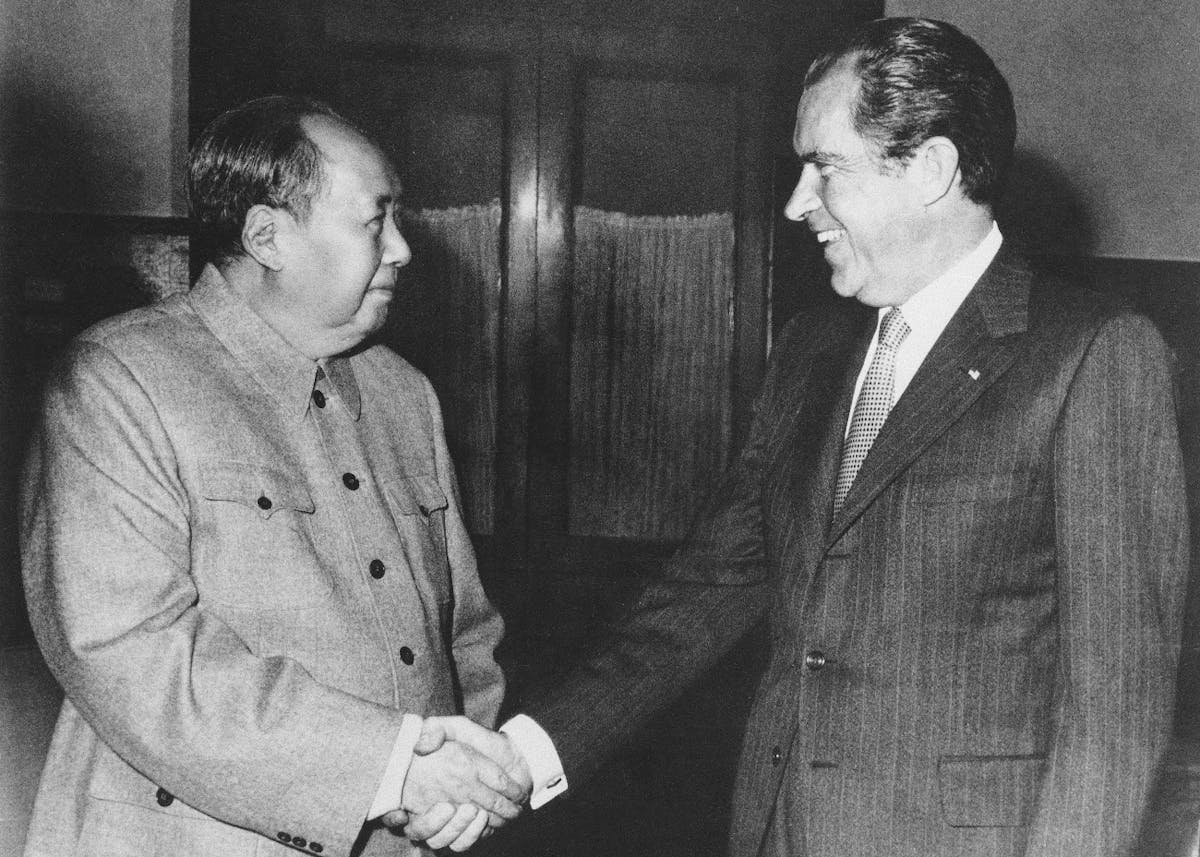Reconsidering Nixon’s China Trip in Light of Damage Done
Nixon’s outreach to Beijing did worry Moscow, but the considerable American aid and support that went to Mao and his successors helped build and enable the foe that we face today.

President Nixon landed in Beijing 50 years ago, beginning the opening of relations between communist China and America. The move was heralded — both at the time and since — as a “master stroke” of diplomacy. Half a century later, though, its legacy looks far less certain.
The significance of the trip is undeniable. The United States had severed relations with China in 1949 when the communists under Mao Zedong defeated the Nationalist Party forces of Chiang Kai-Shek, who — with the Republic of China government founded in 1912 — retreated to Taiwan. For more than 20 years, relations between Mao’s People’s Republic of China and America were marked by open hostility.
Communist China fought American and United Nations forces in the Korean War, and Mao proved to be a committed ideologue. Seeking to position himself as the head of a worldwide movement, Mao supported communist efforts in the Third World, funding and equipping anti-Western insurgencies in Africa, the Middle East, and Asia.
Meanwhile, Mao’s communist regime brought untold death to China. As the historian Frank Dikötter has documented, the so-called Great Leap Forward alone resulted in the deaths of no fewer than 45 million people from starvation and state violence. This was but one of Mao’s bloody attempts at social engineering.
For more than two decades, America refused to recognize the communist regime in China. Richard Nixon, once an advocate for the ROC, eventually came to believe that communist China had to be brought into the fold. In an October 1967 Foreign Affairs article, Nixon argued for engaging the pariah state. “Taking the long view, we simply cannot afford to leave China forever outside of the family of nations.” Elected to the presidency a little more than a year later, Nixon began to lay the groundwork for rapprochement, announcing his intentions in 1971.
On February 21, 1972, Nixon landed in Beijing and, to much fanfare and acclaim, began the process of establishing relations. In a toast to Mao before leaving, he exclaimed: “We have been here a week. This was the week that changed the world.” Indeed, it was — but not, perhaps, in the way that Nixon would have imagined.
Warming relations with China’s communist rulers came at the expense of ties with the Free Chinese Republic, which, in sharp contrast to Beijing, emerged in the 1980s as a multi-party democracy with freedom of religion and the press, and the rights to property and travel.
Nixon and his national security adviser, Henry Kissinger, had hoped to use with Russia and Red China “triangular diplomacy,” allowing, it was thought, America to leverage one communist power off the other to extract concessions. Nixon sought to throw the Soviets, Beijing’s rival for leadership in the communist world, off balance.
Historians and pundits like to point to the period of détente, embodied in numerous subsequent American arms control agreements with the Soviet camarilla, as proof of the strategy’s genius. However, it is also possible to trace the seeds of détente to overtures in the later years of the Eisenhower and Kennedy administrations.
As importantly, the Soviets cheated on many of the arms control agreements and were emboldened in the later 1970s, supporting rebels in Africa and Latin America and invading Afghanistan. The eventual collapse of the Soviet Union and its European satellites, though, owed more to Western resolve and the power of capitalism and to communism’s own inherent flaws.
To be sure, Nixon’s outreach to Beijing did worry Moscow, but the considerable American aid and support that went to Mao and his successors helped build and enable the foe that we face today. Communist China then was poor, isolated, and embattled — precisely the reasons why they welcomed Nixon.
Mao was worried about the Soviet Union, with relations between the two having broken down into border clashes and fears of nuclear war. The Cultural Revolution that he initiated in the 1960s only furthered their troubles. Indeed, Beijing needed Washington far more than the reverse.
The opening, it can be said, was a lifeline to Chinese communists that, for many Americans, increasingly looks like a noose around our own necks.
Publicly Nixon claimed that he hoped to “induce change” in China, but his private expressions were far less optimistic. As the historian James Mann documented, archives show that three weeks before the trip Nixon privately believed that Chinese leaders were “more dedicated to Communism than the Soviets.” In this, at least, he was right.
During Nixon’s trip, Mr. Kissinger reportedly asked Mao’s top lieutenant, Zhou Enlai, what he thought about the French Revolution. “Too soon to tell,” Zhou is supposed to have said. The bill for Nixon’s trip, however, has already come in — and it is steep.
Chinese communism looks to be more enduring than its Soviet forefathers. The PRC today is the wealthiest and most technologically advanced police state in world history, with surveillance powers that a Hitler or a Stalin could only envy.
Beijing seeks to conquer Free China, which remains a key American ally though the treaty itself has been abrogated. Communist China menaces its neighbors and has ended free speech and democracy in Hong Kong and elsewhere. Beijing has even sought to restrict freedom of speech and thought in countries as far away as Lithuania.
Fifty years later, considering the damage — from American manufacturing and supply chains to Beijing’s growing regional hegemony and more — Nixon’s trip to China looks less like a diplomatic masterstroke and more like the beginning of a long-term disaster.

